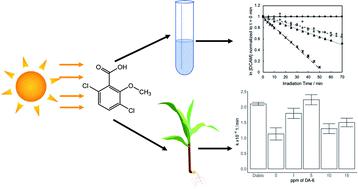当前位置:
X-MOL 学术
›
Environ. Sci.: Processes Impacts
›
论文详情
Our official English website, www.x-mol.net, welcomes your feedback! (Note: you will need to create a separate account there.)
Photolysis of the herbicide dicamba in aqueous solutions and on corn (Zea mays) epicuticular waxes
Environmental Science: Processes & Impacts ( IF 5.5 ) Pub Date : 2021-5-10 , DOI: 10.1039/d1em00058f Kaitlyn Gruber 1, 2 , Brittany Courteau 1, 2 , Maheemah Bokhoree 1, 2 , Elijah McMahon 1, 2 , Jenna Kotz 1, 2 , Amanda Nienow 1, 2
Environmental Science: Processes & Impacts ( IF 5.5 ) Pub Date : 2021-5-10 , DOI: 10.1039/d1em00058f Kaitlyn Gruber 1, 2 , Brittany Courteau 1, 2 , Maheemah Bokhoree 1, 2 , Elijah McMahon 1, 2 , Jenna Kotz 1, 2 , Amanda Nienow 1, 2
Affiliation

|
Dicamba, 3,6-dichloro-2-methoxybenzoic acid, has been used in agriculture as an herbicide for over fifty years, and has seen an increase in use in the past decade due to the development of glyphosate resistant weeds and soybeans genetically modified to resist dicamba. Despite the previous use of dicamba, many questions remain regarding its environmental fate, especially the new commercial formulations used on genetically modified crops. Here, the photolysis of dicamba, including the commercial formulation Diablo®, is examined in aqueous solutions of varying water quality and on the surface of corn epicuticular waxes. Dicamba is stable to hydrolysis but degrades under UV light. The photolytic half-life for dicamba photolysis in aqueous solutions at pH 7 irradiated with Rayonet UVB lamps (280–340 nm) was t1/2 = 43.3 min (0.72 hours), in aqueous solutions at pH 7 in a Q-Sun solar simulator (λ > 300 nm) was t1/2 = 13.4 hours, and on epicuticular waxes irradiated in the Q-Sun solar simulator was t1/2 = 105 hours. Experiments with adjuvants, compounds added into the commercial formulations of dicamba, led to increases in rate constants for both aqueous and wax experiments. In addition to kinetic rate constants, photoproducts were tentatively assigned for the aqueous solution experiments. This work deepens the knowledge of the environmental fate of dicamba including the role surfactants play in chemical reactions and in providing new applications of current methods to examine the photolysis of chemicals sorbed to surfaces.
中文翻译:

麦草畏在水溶液中和玉米(Zea mays)表皮蜡上的光解作用
麦草畏(3,6-二氯-2-甲氧基苯甲酸)在农业上已用作除草剂已有50多年的历史了,在过去的十年中,由于抗草甘膦杂草和转基因大豆的发展,大豆的使用量有所增加。抵抗麦草畏。尽管以前使用麦草畏,但对其环境命运仍存在许多疑问,尤其是用于转基因作物的新型商业制剂。在这里,麦草畏的光解作用,包括商业配方Diablo®,在水质变化的水溶液中和玉米表皮蜡的表面上进行了检测。麦草畏对水解稳定,但在紫外线下会降解。在用Rayonet UVB灯(280–340 nm)照射的pH 7水溶液中麦草畏的光解半衰期为t 1/2在Q-Sun太阳模拟器(λ > 300 nm)中在pH 7的水溶液中= 43.3分钟(0.72小时)为t 1/2 = 13.4小时,在Q-Sun太阳模拟器中照射的表皮蜡为t 1/2 = 105小时。使用佐剂的实验是将化合物加入麦草畏的商业配方中,导致水性和蜡质实验的速率常数增加。除了动力学速率常数外,还将光产物暂定用于水溶液实验。这项工作加深了麦草畏环境命运的知识,包括表面活性剂在化学反应中的作用以及在提供当前方法以检测吸附到表面的化学物质的光解作用的新应用中的作用。
更新日期:2021-05-14
中文翻译:

麦草畏在水溶液中和玉米(Zea mays)表皮蜡上的光解作用
麦草畏(3,6-二氯-2-甲氧基苯甲酸)在农业上已用作除草剂已有50多年的历史了,在过去的十年中,由于抗草甘膦杂草和转基因大豆的发展,大豆的使用量有所增加。抵抗麦草畏。尽管以前使用麦草畏,但对其环境命运仍存在许多疑问,尤其是用于转基因作物的新型商业制剂。在这里,麦草畏的光解作用,包括商业配方Diablo®,在水质变化的水溶液中和玉米表皮蜡的表面上进行了检测。麦草畏对水解稳定,但在紫外线下会降解。在用Rayonet UVB灯(280–340 nm)照射的pH 7水溶液中麦草畏的光解半衰期为t 1/2在Q-Sun太阳模拟器(λ > 300 nm)中在pH 7的水溶液中= 43.3分钟(0.72小时)为t 1/2 = 13.4小时,在Q-Sun太阳模拟器中照射的表皮蜡为t 1/2 = 105小时。使用佐剂的实验是将化合物加入麦草畏的商业配方中,导致水性和蜡质实验的速率常数增加。除了动力学速率常数外,还将光产物暂定用于水溶液实验。这项工作加深了麦草畏环境命运的知识,包括表面活性剂在化学反应中的作用以及在提供当前方法以检测吸附到表面的化学物质的光解作用的新应用中的作用。


























 京公网安备 11010802027423号
京公网安备 11010802027423号